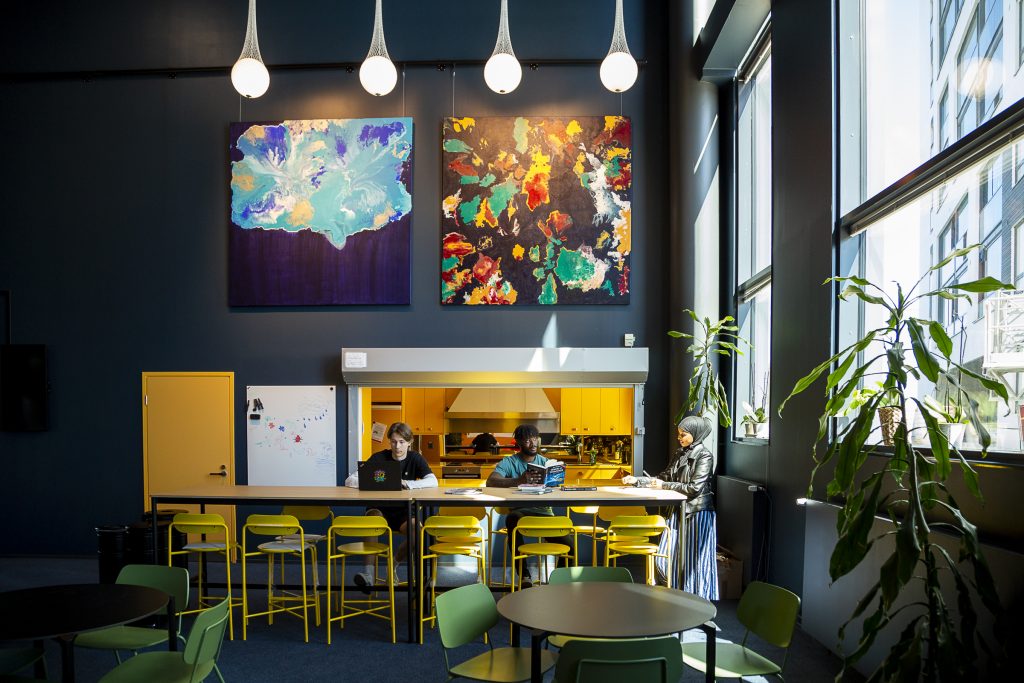
Interior design
Responsible choices are made in interior design projects. The interior design project offers a good opportunity for environmental education, as it has to consider one’s own relationship with the environment – both social and physical – and make choices about materials and working methods.
These choices always have an impact on the environment, because the substance is treated and all the substance originally comes from nature, to which it also returns in time.
When choices are considered together with young people and joint decisions are made, young people’s environmental awareness is strengthened. The interior design project is not just about painting and furnishing, but the space can also be studied experientially and thus the effects of different spaces, colours and materials on us can be observed.
1. Close relationship with nature & space: atmosphere
- What kind of feelings do the spaces evoke? A close relationship with nature:
We tour around the premises of the youth centre, pondering what feelings different places evoke. Where was the most comfortable place to be? Is there something unpleasant or scary? Why? - Premises messages
Listen to an empty room and try to create an echo. Let’s go into a furnished space and touch by hand to see how the materials feel and what they say. Move in a row with eyes covered and hands on the shoulders of the person in front. The line is led by the instructor with their eyes open. Trying to find new perspectives on space (frog and bird perspectives). - Incubating thoughts and ideas
Browse interior design magazines and cut ideas from them into your own project. Wonder who to decorate for? Only for us or maybe for others? What kind of people is the youth centre decorated for? - What would my dream room be like?
What would be there and what would it look like there? Collect colour and material collages from the group members’ dreams and make them into an exhibition. Don’t judge the works, but look at them together. Everyone can tell of their own work what they want – if they want to. - Paradise in the corner of the youth centre
Bringing nature in as green plants. Living plants revitalise and purify the air. Let’s hold brainstorming meetings under the shadow of green plants.
2. Environmental deeds: Things to do together
- Let’s decide together what to buy new and what makes sense to get as used.
Let’s become acquainted with the Recycling Centre’s website and make a purchase trip to the Recycling Centre. Purchases can be made with the Kosti tag. - When purchasing new furniture, the importance of domesticity, repairability, versatility and furniture cleaning is considered.
How much value is placed on these things? - When purchasing yard furniture, FSC – marked furniture made of certified wood is introduced.
Would it be possible to obtain such furniture? Is it possible to purchase domestic furniture? Is it possible to purchase domestic furniture? - Consider which of the youth centre’s old furniture, curtains and pillows could be vamped up.
- Let’s become acquainted with energy-saving lighting methods and choose the most suitable one. Natural light should also be considered!
- The interior is designed so that heat can enter the room without hindrance and the room is easy to clean.
- Let’s discuss whether it would make sense to get heat-insulating curtains.
- Decide what kind of sorting bins are needed for the premises. Get them and make sorting instructions.
- Find out if it is possible to get eco-labelled water-soluble paint if you decide to paint the walls.
- Protect the floors with paper during the painting. Sometimes just newspapers are enough. Plastic is often useless. Together, we will develop ways in which tools can be cleaned without an abundant water runoff.
3. Own inspirations: Ideas & Information
- A wide variety of materials are used in interior design, so in terms of environmental information it is essential to discuss how the substance circulates on Earth. Such a discussion can take place during the work or even during the final evaluation.
- Consider where the materials we used in the interior design project originally came from.
What materials does the sofa contain and where are they obtained? - What happens to these goods when we no longer use them?
Can they be recycled, repaired, reused? How long does it take for these substances to decompose totally? - Did we use a lot of plastic?
Where does plastic come from? What happens to plastics when they are removed from use? Let’s watch plastic videos on YouTube, e.g. with the keywords Great Pacific Garbage Patch, Water in our Environment, Trash disposal.
